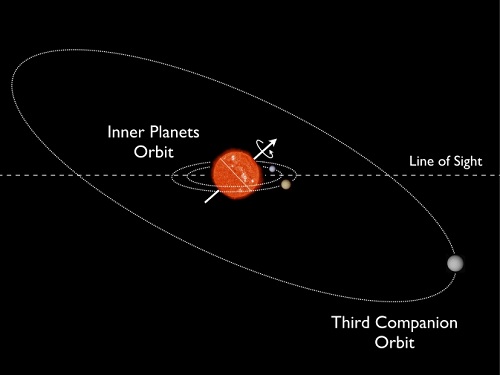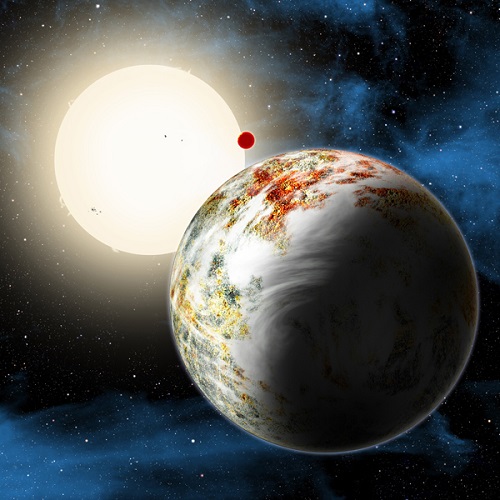Centauri Dreams
Imagining and Planning Interstellar Exploration
Kepler-56: Misaligned Planets Around a Swelling Star
Although I’m sure I’ll refer to various papers presented at the American Astronomical Society this week in future entries, I’ll close our current look at the Boston meeting with word of two planets that will be falling into their star in short order (at least as astronomers measure time). Kepler-56b and Kepler-56c have a predicted era of death, some 130 million and 155 million years from now respectively. I can’t think of any other exoplanets about which we’ve been able to make such statements, making this a system worth watching as we ponder our own Sun’s future.
Just as the Sun will one day enlarge to red giant status, threatening the inner planets, so Kepler-56 is growing, already reaching four times the size of the Sun. The star has a long way to go as it continues its outward expansion, and the two planets in question are in a perilous position, with Kepler-56b orbiting the host star every 10.5 days, and Kepler-56c every 21.4. Gongjie Li (Harvard-Smithsonian Center for Astrophysics) and team have worked the number’s on the star’s evolution, leading to this prediction about the inner worlds’ demise.
You may recall this system as the first multi-planet system to be found with a tilt, as the orbits of the two inner planets are tipped from the star’s equator. Li told her session at the AAS conference that while the inner planets will be gradually destroyed by the star, heated enough to boil off any atmospheres and stretched by stellar tides along the way, a third known planet in this system, Kepler-56d, will be far enough out to survive. The latter is a gas giant in a 3.3 year orbit, and the researchers now believe that its orbit is tilted relative to the star as well. Such systems demand explanation since we would expect that planets formed from the same gas and dust disk as their host star would orbit in the plane of the star’s equator, as we see in our own system.

Image: Graphical sketch of the Kepler-56 system. The line of sight from Earth is illustrated by the dashed line, and dotted lines show the orbits of three detected companions in the system. The solid arrow marks the rotation axis of the host star, and the thin solid line marks the host star equator. Credit: NASA GSFC/Ames/D Huber.
Li pointed out in Boston that finding the inclination of the outer companion was important in helping us learn about the processes that produced the planetary misalignments. Last October I wrote about Daniel Huber’s work at NASA Ames involving the misalignment of the Kepler-56 inner planets with the host star. We do know of systems where ‘hot Jupiters’ are found that are not aligned with the equatorial plane of their hosts. Is this the result of planetary migration and chaotic close encounters with other planets in the system? If that is the case, then multi-planet systems without hot Jupiters should not show misalignment with the host star.
But we have no hot Jupiters around Kepler-56. Huber’s team used radial velocity measurements from the HIRES instrument at the Keck 10-meter telescope to study the system, seeing the signature of a third planet in a wide orbit (Kepler-56d) that was likewise misaligned from the equatorial plane of the star. It’s that outer planet that could in Huber’s view, have torqued the orbits of the inner planets out of the star’s equatorial plane. From the paper:
The inner planetary orbits would stay aligned with one another because of strong coupling between their orbits, resulting in a misalignment of the two co-planar transiting planets with the host star. Dynamical simulations that include a third companion in an eccentric orbit inclined to the equatorial plane of the host star confirm that such a mechanism can reproduce the architecture of the Kepler-56 system.
At 3000 light years from the Earth, Kepler-56 turns out to be a fascinating system. Huber found the rotation axis of the star tilted about 45 degrees to our line of sight at the same time that we were seeing the two transiting inner planets (Kepler-56d was detected solely by radial velocity methods). Both Li’s and Huber’s earlier work point to misalignment like this not being caused by hot Jupiters, and leave open for study how Kepler-56’s tilting mechanism could be at play around other stars. The important work ahead is to further constrain the inclination of the outer planet, Kepler-56d.
The Huber paper is “Stellar Spin-Orbit Misalignment in a Multiplanet System,” Science Vol. 342, No. 6156 (18 October 2013), pp. 331-334 (abstract).

Three Regimes of Planet Formation
On Tuesday I mentioned the work of Lars A. Buchhave, an astronomer at the Harvard-Smithsonian Center for Astrophysics (CfA), in connection with the Kepler-10c discovery. The latter is the so-called ‘mega-Earth’ now found to be seventeen times as massive as our own planet, with a diameter of about 29,000 kilometers. A larger population of solid planets with masses above 10 times that of Earth was suggested in the Kepler-10c paper (see Introducing the ‘Mega-Earth’ for more on this), with reference to Buchhave’s ongoing work.
Let’s take a closer look at what Buchhave is doing, because the intriguing fact is that planets four times the size of Earth and smaller comprise about three-quarters of the planets found by the Kepler mission. How large a role does the metallicity of the host star play in planet formation?
At the ongoing meeting of the American Astronomical Society in Boston, Buchhave explained his research methods, which involve measuring ‘metals’ — in astronomical parlance the elements heavier than hydrogen and helium — in stars hosting exoplanets. His team analyzed more than 2000 high-resolution spectra of Kepler Objects of Interest, yielding the metallicities and other parameters of 405 stars orbited by 600 exoplanet candidates.
A statistical examination of the results followed, with this outcome: Planet-hosting stars fall into three groups that can be defined by their compositions. Buchhave’s team found two dividing lines, one at 1.7 times Earth’s radius, the other at 3.9 times the radius of Earth. The inference is that planets smaller than 1.7 Earth radius are completely rocky, while those above 3.9 Earth radius are most likely gas giants. [Addendum: See kzb’s comment below re a mistake I made in the initial version of this post.]
That interesting region between 1.7 and 3.9 times the size of Earth is where we find the so-called ‘gas dwarfs,’ planets whose cores accreted gas from the protoplanetary disk but failed to grow into gas giants of Jupiter-class or larger. Says Buchhave:
“It seems that there is a ‘sweet spot’ of metallicity to get Earth-size planets, and it’s about the same as the Sun. That makes sense because at lower metallicities you have fewer of the building blocks for planets, and at higher metallicities you tend to make gas giants instead.”
From the paper:
…the observed peak in the metallicity–radius plane at 1.7R? suggests that the final
mass and composition of a small exoplanet is controlled by the amount of solid material available in the protoplanetary disk. A higher-metallicity environment promotes a more rapid and effective accretion process, thereby allowing the cores to amass a gaseous envelope before dissipation of the gas. In contrast, lower-metallicity environments may result in the assembly of rocky cores of several Earth masses on timescales greater than that inferred for gas dispersal in protoplanetary disks (<10 Myr), yielding cores without gaseous hydrogen–helium atmospheres.
To produce small, terrestrial worlds, then, stars with metallicities similar to the Sun are favored, while stars with gas dwarfs are likely to be those that are slightly more metal-rich. The stars most likely to produce gas giants contain the most metals, generally fifty percent more than the Sun. The finding is intriguing but comes with the caveat that Kepler is best at finding planets relatively close to their star, and the metallicity thesis needs to be tested over a wider range of orbits.

Image: Three kinds of planetary outcome are suggested by the metallicity of the host star, according to new work by Lars A. Buchhave and team. Credit: David Aguilar, CfA.
Whether or not Buchhave’s work can explain a Kepler-10c will depend upon gathering a larger sample of such worlds to work with. But so far his analysis implies that there is no evident cutoff in size for rocky worlds, the data showing that the mass and radius indicating the transition from rocky to gaseous planets should increase with orbital period:
Although additional data are required to confirm this relationship, the fit is apparently consistent with a critical core mass that increases with orbital period and an atmospheric fraction of 5%… If correct, this predicts the existence of more massive rocky exoplanets at longer orbital periods.
Thus the farther a planet is from its star, the larger it can grow before the accretion of a thick atmosphere turns it into a gas dwarf. When we have the observational tools to examine a wide range of planets in outer-system orbits, we may be able to confirm or refute Buchhave’s suggestion that truly massive ‘super-Earths’ like Kepler-10c may not be uncommon.
The paper is Buchhave et al., “Three regimes of extrasolar planets inferred from host star metallicities,” Nature 509 (29 May 2014), pp. 593-595 (abstract / preprint).

Probing an Ancient Planetary System
The red dwarf known as Kapteyn’s Star — the name comes from the 19th Century Dutch astronomer Jacobus Kapteyn — is about thirteen light years from Earth in the southern constellation of Pictor, close enough that a small telescope can pick it out. Kapteyn’s efforts at cataloguing the star in 1898 revealed that it had the highest proper motion of any star then known, a position it lost with the discovery of Barnard’s Star in 1916. Because I find stellar encounters interesting, I’ll note that about 11,000 years ago, Kapteyn’s Star would have come within seven light years of the Sun. It has been moving away from us ever since.
Kapteyn’s Star belongs to the galactic halo, a dispersed population of stars on elliptical orbits that wraps around the galactic disk and bulge. It is the nearest known halo star to the Sun. We now know, through the efforts of an international research team, that at least two planets are found here. Kapteyn c is a ‘super-Earth’ with an orbit of 121 days, while Kapteyn b comes in at about five Earth masses and orbits the star every 48 days, potentially making it warm enough for liquid water to exist on the surface. Bear in mind that this is the 25th nearest star to the Sun, a star with a history that evidently includes birth in an original dwarf galaxy now known as Omega Centauri, which was long ago absorbed and disrupted by its encounter with the Milky Way.

Image: Kapteyn’s Star and its planets likely come from a dwarf galaxy now merged with the Milky way. The bottom right panel shows characteristic streams of stars resulting from such a galactic merging event. Credit: Victor Robles, James Bullock, and Miguel Rocha at University of California Irvine and Joel Primack at University of California Santa Cruz.
The paper explains this intriguing background and estimates the star’s age:
The age of Kapteyn’s star can be inferred from its membership to the Galactic halo and peculiar element abundances (Kotoneva et al. 2005). The current hierarchical Milky Way formation scenario suggests that streams of halo stars were originated as tidal debris from satellite dwarf galaxies being engulfed by the early Milky Way (Klement 2010, and references therein). This scenario is supported by the age estimations of the stars in the inner halo (~10-12 Gyr, Jofré & Weiss 2011), and globular clusters. The work by Eggen and collaborators… established the existence of such high-velocity, metal-poor moving groups in the solar neighborhood. Kapteyn’s star is the prototype member of one of these groups…
So we’re dealing with an ancient star with an age not likely to be less than 10 billion years, and perhaps much older (the obvious upper cut-off being 13.7 billion years). The paper speculates that detecting two super-Earths around Kapteyn’s Star is consistent with the idea that low-metallicity stars tend to produce low-mass planets rather than gas giants, an idea supported by the small number of low mass planets found in radial velocity searches of metal-rich stars.
It’s also interesting to consider, as the paper does, that at the likely age of the Kapteyn’s Star system, most G and K dwarfs would be evolving away from the main sequence into giants, which would make detecting planets around them through Doppler methods all but impossible because of the high level of solar activity. The result: If we want to learn about the oldest planetary systems in the galaxy, we’ll need to turn to low-mass stars like this one, which remain on the main sequence and will stay there for a long time to come.
If you’re a science fiction fan, you’ll want to check out this news release from the University of London, which interweaves within the text a short story by Alastair Reynolds called ‘Sad Kapteyn.’ The tale describes in just a few paragraphs the arrival of a robotic interstellar probe at the Kapteyn’s Star planetary system. Reynolds is always worth reading (the Revelation Space novels in particular), and I quote him here as he recounts the AI probe’s discovery of a long-dead civilization on Kapteyn b:
“Continent-sized craters mar Kapteyn b, and I wonder if they speak of some truly awesome catastrophe – a cosmic accident, or something worse? Whatever the case, the builders of these cities are long gone. Perhaps they were dead even before Kapteyn’s star was snatched from the clutches of its mother galaxy.
“At the risk of inferring too much from too little data, I can’t help indulging in a little speculation. I too was the product of a technological civilisation, with the capability to transform a planet, to colonise other moons and worlds, to build daunting structures. The people of Kapteyn b were clearly more advanced than you, my own builders – but given time, you too could have transformed a world in this manner.
“Something to think about, isn’t it?”
The paper is Anglada-Escudé et al., “Two planets around Kapteyn’s star: a cold and a temperate super-Earth orbiting the nearest halo red-dwarf,” accepted at Monthly Notices of the Royal Astronomical Society (preprint).

Introducing the ‘Mega-Earth’
Building public interest in deep space is a long-term goal for most of us in the interstellar community, and the release of the film Interstellar this fall may set off a new round of discussion among reviewers and movie fans alike. Also helpful is the DVD release of the Neil deGrasse Tyson Cosmos series, given Tyson’s performance and the stunning visuals that communicate the majesty and power of the universe around us.
But I think it’s encouraging that while these blockbuster media releases work their magic, what used to be staid scientific conferences frequented only by specialists are turning into media events of their own. The American Astronomical Society is currently meeting in Boston, with exoplanet papers that I’m already seeing discussed well outside the usual venues. The more we see the excitement and sheer scope of the exoplanet hunt communicated to the public, the more likely we’re building the kind of interest among young people that may one day turn into scientific careers and — dare I say it — funding for missions that will fly beyond our system’s edge.
Maybe Dimitar Sasselov (Harvard-Smithsonian Center for Astrophysics) had a bit of media buzz in mind when he described a rocky world known as Kepler-10c as “the Godzilla of Earths.” The finding is exciting enough that he can, in any case, be forgiven the hyperbole. Kepler-10c is located about 560 light years from us in the constellation Draco, orbiting its host star every 45 days. A second world in this system, the star-hugging Kepler-10b, was the first rocky planet detected by Kepler and confirmed by radial velocity follow-ups from Earth. With a diameter of about 29,000 kilometers, Kepler-10c looked to be another ‘mini-Neptune,’ a world with a thick atmosphere covering a much smaller rocky core.
The surprise came when a research team led by Sasselov’s colleague Xavier Dumusque at the CfA went to work with the HARPS-North instrument on the Telescopio Nazionale Galileo (Canary Islands) to measure the mass of the planet. The result: Kepler-10c weighs fully 17 times as much as the Earth, demonstrating it is made of rocks and other solids. A rocky planet on this scale is beyond the designation ‘super-Earth.’ This CfA news release calls it a ‘mega-Earth,’ a world that we would have expected to have become the core of a Neptune- or Jupiter-class gas giant.

Image: The newly discovered “mega-Earth” Kepler-10c dominates the foreground in this artist’s conception. Its sibling, the lava world Kepler-10b, is in the background. Both orbit a sunlike star. Kepler-10c has a diameter of about 18,000 miles, 2.3 times as large as Earth, and weighs 17 times as much. Therefore it is all solids, although it may possess a thin atmosphere shown here as wispy clouds. Credit: David A. Aguilar (CfA).
The paper on this work notes that “Kepler-10c might be the ?rst ?rm example of a population of solid planets with masses above 10 M?.” And it goes on to discuss the work of Lars A. Buchhave, a CfA astronomer who likewise presented at the AAS meeting in Boston, whose work supports the idea that orbital period correlates with the size at which a planet makes the transition from rocky to gaseous:
If this model is correct, it implies that the core mass limit for gas accretion should increase with orbital period. A recent study from Buchhave et al. (2014, in press.), analyzing hundreds of Kepler candidates, seems to agree with this theoretical prediction. With a period of 45.29 days, a radius of 2.35 R?, and a density higher than Earth, Kepler-10c would be at the limit of the transition from terrestrial to gaseous planets observed by Buchhave et al. (2014, in press.). Kepler-10c might be the ?rst object con?rming that longer period terrestrial planets can be more massive than ones with shorter periods.
The implication is that Kepler-10c is not likely to be the last ‘mega-Earth’ we find. And this is interesting:
We note that Kepler-131b (Porb = 16 days, 16.1 ± 3.5 M?, 2.4 ± 0.2 R?, Marcy et al. 2014) lies in the same location of the mass-radius diagram as Kepler-10c. However the mass determination of Kepler-131b is not as robust as for Kepler-10c and more data are needed to con?rm the high density of this planet. Measuring precisely the mass of several other long-period Kepler candidates orbiting bright stars could test this speculation. This experiment has just been started as a new observational program on HARPS-N.
Observational errors dominated by photon noise are a problem with a star as faint as Kepler-10, and the paper adds that future transit searches focusing on bright stars will allow the high-quality radial velocity findings needed to measure planetary masses to greater precision. The TESS (Transiting Exoplanet Survey Satellite) mission should provide numerous candidates, as should the ESA’s PLATO mission (PLAnetary Transits and Oscillations of stars).
Meanwhile, we may be learning something new about the early universe, for the Kepler-10 system is some 11 billion years old. Huge, rocky planets could evidently form despite the fact that heavy elements were scarce in this era. Says Sasselov: “Finding Kepler-10c tells us that rocky planets could form much earlier than we thought. And if you can make rocks, you can make life.” Even stars as old as this one, then, shouldn’t be ruled out when we look for astrobiology candidates, a finding that expands the parameters of our search for life elsewhere in the universe.
The paper is Dumusque et al., “The Kepler-10 planetary system revisited by HARPS-N: A hot rocky world and a solid Neptune-mass planet,” accepted for publication in The Astrophysical Journal (preprint).

Starflight, Simulation and Deception
In our email conversations leading up to my publishing Human Universals and Cultural Evolution on Interstellar Voyages, Cameron Smith confirmed that there were few anthropologists engaged in studying long-term spaceflight. The same can be said for historians and sociologists, although we do have some prominent names devoting themselves to changing that. Kathleen Toerpe is doing splendid work with the Astrosociology Research Institute (I’m hoping for a new report from her soon in these pages), while Interstellar Migration and the Human Experience (1985) made a determinedly multidisciplinary effort to study our place in the cosmos.
The latter book was actually the proceedings of the Conference on Interstellar Migration held in Los Alamos in 1983, and it remains a storehouse of insights into spaceflight’s effect on humanity. Presenters at the 100 Year Starship symposia have thus far been multidisciplinary as well, with representation from biologists, philosophers, writers and psychologists as well as scientists working the ‘hard science’ fields of propulsion and aerospace engineering. Of course, the place where starflight is most vividly presented from all angles of human experience is in science fiction, which over the years has explored many of the issues raised by, for example, putting a human crew into a multi-generational starship and shooting for Alpha Centauri.
Reading Cameron Smith’s essay, though, had me thinking all weekend about some of the fictional situations great writers have gotten their interstellar crews into. A trip that takes a thousand years inspires thoughts of generations that eventually forget their mission and may not realize they are on a starship. This is familiar turf, worked by Brian Aldiss in his novel Non-Stop (1958), and of course famously portrayed by Robert Heinlein in Orphans of the Sky, which grew out of two novellas in Astounding Science Fiction. Ever the bibliographer, I must mention both: “Universe,” in ASF May, 1941, and the sequel “Common Sense,” which ran in October of the same year.

But if crews that forget where they are is a classic trope of science fiction, somewhat less so is the different kind of ignorance portrayed by J. G. Ballard’s crew in “Thirteen to Centaurus,” a story mentioned by Centauri Dreams commenter Alex Tolley over the weekend. Here the issue is how human crews react to long-haul spaceflight, and we learn early on in the story that the narrative being told by the authoritative ship’s doctor is not exactly what it seems. Here he’s speaking with a young man who has come to believe that his ‘world’ may be a ship:
“You’d more or less guessed before I told you. Unconsciously, you’ve known all about it for several years. A few minutes from now I’m going to remove some of the conditioning blocks, and when you wake up in a couple of hours you’ll understand everything. You’ll know then that in fact the Station is a spaceship, flying from our home planet, Earth, where our grandfathers were born, to another planet millions of miles away, in a distant orbiting system. Our grandfathers always lived on Earth, and we are the first people ever to undertake such a journey. You can be proud that you’re here. Your grandfather, who volunteered to come, was a great man, and we’ve got to do everything to make sure that the Station keeps running.”
Abel nodded quickly. “When do we get there — the planet we’re flying to?”
Dr. Francis looked down at his hands, his face growing somber. “We’ll never get there, Abel. The journey takes too long. This is a multi-generation space vehicle, only our children will land and they’ll be old by the time they do. But don’t worry, you’ll go on thinking of the Station as your only home, and that’s deliberate, so that you and your children will be happy here.”
This all seems familiar for a time, but of course this is J. G. Ballard, in whose hands the tools of science fiction take evocative new form. Normally I would worry about spoiler alerts, but this is a short piece and the reader learns early on that things are not what they seem, so I feel comfortable saying that Dr. Francis is himself lying, that the ship is a long-term Earthbound experiment, and that its crew is being used to study the problems humans will have when we really do send ships to another star. The boy Abel is smart enough to start seeing through even this subterfuge, and our friend Dr. Francis learns he has an agonizing decision to make.

Published in the April, 1962 issue of Amazing Stories — then under the leadership of Cele Goldsmith, whom I consider one of science fiction’s great editors — “Thirteen to Centaurus” was also dramatized by the BBC in 1965 as part of its ‘Out of the Unknown’ series. If you’re not a collector of old magazines, you can track it down in 1963’s collection Passport to Eternity, or more easily still in 2010’s The Complete Stories of J. G. Ballard.
It would be interesting to know how much of an influence the Ballard tale played on Bruce Sterling, whose story “Taklamakan” won a 1999 Hugo Award. Here simulation again comes into play, this time in a remote cave under the Taklamakan desert. There, within three enormous structures each the size of a high-rise building, what one of the characters calls ‘a dry-run starship experiment’ is ongoing, an entire, isolated community having been chosen for the task, which has aspects of both ethnic cleansing and scientific study. The characters ‘Spider Pete’ and Katrinko talk over the ramifications:
“You suppose these guys really believe they’re inside a real starship?”
“I guess that depends on how much they learned from the guys who broke out of here with the picks and the ropes.”
Katrinko thought about it. “You know what’s truly pathetic? The shabby illusion of all this. Some spook mandarin’s crazy notion that ethnic separatists could be squeezed down tight, and spat out like watermelon seeds into interstellar space. . . . Man, what a come-on, what an enticement, what an empty promise!”
“I could sell that idea,” Pete said thoughtfully. “You know how far away the stars really are, kid? About four hundred years away, that’s how far. You seriously want to get human beings to travel to another star, you gotta put human beings inside of a sealed can for four hundred solid years. But what are people supposed to do in there, all that time? The only thing they can do is quietly run a farm. Because that’s what a starship is. It’s a desert oasis.”
And maybe you’ll remember one last story that traded off isolation and experimentation on human crews. The very first episode of Rod Serling’s series The Twilight Zone was “Where Is Everybody?” First broadcast in October of 1959, the story, written by Serling, stars Earl Holliman as a man who finds himself in a town where no one seems to exist, even though evidence of recent occupation is everywhere. We learn at the end that the character Holliman plays, Mike Ferris, is an astronaut in training. He’s been inside an isolation room for almost 500 hours during a simulated trip to the moon. Can the human mind handle deep space in tiny spacecraft?
The message of the show is ‘yes,’ as Ferris looks out and sees the Moon when he is being taken on a stretcher to the hospital. His hallucinations haven’t altered his determination. He yells into the sky:
“Hey! Don’t go away up there! Next time it won’t be a dream or a nightmare. Next time it’ll be for real. So don’t go away. We’ll be up there in a little while.”

Human Universals and Cultural Evolution on Interstellar Voyages
Cameron Smith last joined us just over a year ago with an essay on human interstellar migration in the context of biological evolution. Here he turns to issues of culture and change over time. An anthropologist and prehistorian at Portland State University in Oregon, Dr. Smith brings insights he has gained in the study of the early human experience on Earth to the manifold problems confronting us as we head for the stars. His current work on interstellar issues is part of his engagement with Project Hyperion, an attempt by Icarus Interstellar to develop parameters and reference studies for a multi-generational worldship. Be aware of Dr. Smith’s excellent recent volume Emigrating Beyond Earth: Human Adaptation and Space Colonization (Springer-Praxis, 2013), and ponder the synergies that occur between the study of past human migrations and the ongoing cultural and biological evolution of a species aspiring to leave the world that gave it birth.
by Cameron M. Smith, PhD

1. Biological and Cultural Evolution
Any change in the heritable properties of a population over generations is evolution, and we can be sure that the human genome will evolve on multigenerational interstellar voyages, just as it continues to evolve here on Earth today. Even in relatively short, 5-generation voyages, a relatively small gene pool for humanity would have to be carefully composed to prevent collapse in the form of a demographic ‘extinction vortex’ following, for example, a catastrophic plague. This is all clear from elementary population genetics, as I pointed out recently in a technical article in Acta Astronautica1—and it’s important to note that not only will we have to be careful to ensure the genetic health of humanity, but also that of all our plant and animal domesticates and symbionts.2
And, we must remember that genetic information is, in the human lineage, only one channel or stream of adaptive, evolving information; another is culture.3 Culture evolves as surely as biology; like genes, information is replicated (culturally, in the form of ideas), varies in its expression, and those variable expressions of ideas do not all survive to be transmitted to the next generation, but some are more-often copied than the rest; culture, then, does not merely change by a process analogous to biological evolution, it does indeed evolve, albeit in its own way.4 While natural selection has not been entirely buffered out with technology, in human cultural evolution it has largely been replaced by ‘cultural selection’; two examples on opposite ends of a spectrum of selection are propaganda, the deliberate spread of certain information in a population, and censorship, deliberate prevention of the spread of such information. While these are driven by conscious motives, a significant difference from natural selection, which has no intent or purpose, these remain selection in that they alter the frequency of ideas in a culture, and shape its history.
2. How Will Human Culture Evolve Beyond Earth?
We can be sure that our genome will be shaped by new conditions, and some such adaptations, to new gravity environments for example, may be predicted based on what we know of human genetic diversity and adaptability. Can we say anything similar about how human culture might evolve? We can, but we must remember that culture change is much more rapid than biological change. With mass media, an idea can be presented to, and affect the behavior of, billions of people in a matter of seconds. For this reason, culture change is more historically contingent and less orderly, we might say, than biological change. But human behavior is not random, and there are patterns.
For example, in all human cultures a number of basic issues must be solved for sheer survival; an individual needs certain quantities of calories, fresh water and nutrients daily, and the way these are obtained can be strongly conditioned by the immediate resource environment. This has led to humanity, worldwide, developing or evolving cultural traits—”human universals”—that reflect basic problem-solving for the kinds of life form that we are, biologically and socially. An example of this is our subsistence mode. While this differs widely in detail worldwide, all humans have solved basic subsistence needs in one of four main modes of subsistence; foraging (hunting and gathering), pastoralism (raising domesticated animals), horticulture (low-intensity farming and animal domestication) or agriculture (intense farming with complex irrigation and animal domestication). These work for humanity, as opposed to, for example, photosynthesis (not available to [directly] process energy in most animal life). And, the mode of subsistence strongly conditions many cultural variables; for instance, foraging people are normally rather egalitarian, with few instances of social ranking, while among horticulturalists and agriculturalists, social ranking (inequal access to resources by population members) is common. In this case, elementary issues such as social ranking ethos are strongly conditioned by subsistence mode. There are plenty of other factors that play into the shape of a culture, and responsible anthropologists are careful not to be ‘ecological determinists’. But we can learn from such cases.
3. Where to Begin? ‘Human Universals’
Where to begin? It’s easy to be overwhelmed when we begin to think about how human culture will change on multigenerational voyages. To order my thoughts, I have begun to tackle this issue by researching the above-mentioned “human universals”. Again, these are domains of behavioral regulation common to all human cultures. For example, all cultures, in one way or another, regulate sexual behavior, and incest in particular. All human cultures also have basic moral systems for dealing with truth-telling, property theft, and killing. And all human cultures have distinctive languages, styles of bodily decoration, family structure and so on. Remember, the ways that these issues are solved differs by culture (leading to tremendous cultural diversity worldwide), but a set of universal cultural facets is a good place to start when we consider what we might expect to evolve beyond Earth. Table 1 displays some universal cultural domains (over 50 have been identified by anthropologists5), explains the concept of the domain, and provides an example of some alternatives.
Table 1. Common Cultural Domains
| Domain | Concept | Examples |
|---|---|---|
| Language | Specific spoken and gestural (bodily) systems of communication, including vocabularies and grammars. | Some languages assign gender to nouns, while others do not. |
| Ethics | Concepts of right and wrong, justice, and fairness. | Some cultures execute murderers, while others do not. |
| Social Roles | Rights and responsibilities differ by categories such as age (child, adult), gender (man, woman), and status (peasant, King). | Cultures differ in the ages at which people take on certain rights and responsibilities, and specifically what those rights and responsibilities are. |
| The Supernatural | Concepts regarding a universe considered fundamentally different from daily experience. | Different cultures worship different gods, goddesses, and other supernatural entities. |
| Styles of Bodily Decoration | Human identity is often communicated by bodily decoration, either directly on the body or with clothing. | Some cultures heavily tattoo the body while others communicate identity more with clothing styles |
| Family Structure | Concepts of kinship or relations between kin, and associated ideas such as inheritance | Some cultures are polygynous, where males have several wives, and some are polyandrous, where females have several husbands. |
| Sexual Behavior | Regulation of sexual behavior, including incest rules. | Cultures differ in the age at which sexual activity is permitted. |
| Food Preferences | Concepts of what are appropriate food and drink in certain situations. | Some cultures eat certain animals while others consider them unfit to eat. |
| Aesthetics | Concepts of ideals, beauty, and their opposites. | Some cultures value visual arts more than song, and vice versa. |
| Ultimate Sacred Postulates | Central, unquestionable concepts about the nature of reality. | Some cultures consider time to be cyclic while others consider it linear. |
Rather than generally cast about, then, grasping for what might change over generations of human cultural evolution during future voyages to distant worlds, each of us guided by our own specific ideas and interests, we can systematically use the tools of anthropology and the principles of evolutionary theory to make useful predictions and recommendations to care for the cultural health of interstellar migrant populations.
Such recommendations are often considered ‘meddling’ or ‘social engineering’ by critics, but of course every new law we pass, every tradition we begin to follow, every marriage we sanction or disallow is ‘social engineering’. I take the view that rather than interfering with ‘natural’ culture change, such informed regulation of culture would make for a better future (especially for future human voyagers) than if we left things to ‘fate’. That could too easily go wrong, as we see in the last century of global warfare, where civilization is a thin veneer, nothing more than a set of agreements that, once and easily breached, result in conflict. Thinking clearly about what might befall future generations is not social engineering, it is taking care of the future, as we do by purchasing insurance individually, or working to ensure universal human rights by the passage of international regulations on certain behaviors.6
4. Two Guidelines for Multigenerational Cultural Health
As mentioned, currently I have no clear recommendations, but I am working on many in my research for a forthcoming book, (tentatively titled Principles of Space Anthropology). For example, while we cannot be certain how the regulation of sexual behavior, a cultural universal, will play out in detail off-Earth, we can be certain that it will be adjusted to accommodate a lower population growth rate than we have in many areas of Earth today. If interstellar voyagers are to emphasize no, or very low population growth for some generations, for instance, social institutions and sanctions might well be used to delay impregnation until somewhat later in life than we see, for example, in developed countries today. Marriages themselves might be carried out at a substantially later age than we are accustomed to, and out-of-wedlock births might be significantly discouraged by social means. In one way or another, the finite size and resources of the interstellar vehicle or vehicles would demand a low-or-no population growth ethos for some centuries, and this would surely affect reproductive rights and result in some kind of regulation of sexual behavior. How do we decide what recommendations to make for planning interstellar voyaging? I have at least two guiding principles that will help condition my own recommendations.
First, human culture, and evolution in general, do not typically tolerate rapid and significant structural change. There are many reasons for this, including the fact that bodies and cultural values are somewhat tailored to modern or even ancient conditions, and radical change on a short scale might well dissolve the close connection between the anatomical or cultural feature and the environmental variable. For this reason, I tend not to recommend new and radical social structures or other arrangements for interstellar voyages. Rather, I think it will be best to use social and cultural arrangements that have been familiar to humans for thousands of years; people should not be arranged, then, in new kinds of family structure, or unfamiliar housing such as ships’s barracks, but as families living in familiar environments including villages and towns connected by travel routes that pass through uninhabited areas.
Second, concerning the populations of interstellar vessels, I strongly believe that we should go in large numbers rather than small, barely-sufficient numbers. While some human populations have been able to survive for centuries in the low hundreds, even cut off from other breeding populations, such cases are exceptions to the rule that human populations are interlinked, yielding genetic populations not of just hundreds of individuals, but multiple thousands. This accords with what we see in vertebrates in general, and mammals and primates in particular, where natural and genetically healthy populations rarely drop below 5,000. I also recommend doubling or tripling the outsetting population to guard against the possibility of catastrophe; plague is a particularly terrifying spectre for enclosed populations, and just as passenger aircraft wings are engineered to take not 3 g’s but 10 or more g’s before failure, safety margins should be built into such plans. Since populations alone can significantly affect the shape of cultural universal adaptions, these must be considered together.
The prospect of interstellar voyaging to spread and preserve humanity and civilization is too great a leap for some to make; they call it ‘pie in the sky’, ‘irresponsible dreaming’, ‘escapism’ and plenty else. My anthropological perspective suggests these are all pessimistic critiques from people lacking in creativity or foresight—or even the hindsight that reveals the ruins of each of the ancient civilizations. I am thrilled to be working with Icarus Interstellar to slowly assemble the puzzle pieces required to provide the breathtaking option of long-term space settlement for humanity over the next 100 years.
References
1. Smith, C.M. 2014. Estimation of a Genetically Viable Population for Multigenerational Interstellar Voyaging: Review and Data for Project Hyperion. Acta Astronautica 97(2014):16-29 (abstract).
2. Xu, J. and J.I. Gordon. 2003. Honor thy Symbionts. Proceedings of the National Academy of Sciences 100(18):10452-10459.
3. Whiten, A., R.A. Hinde, K.N. Laland and C.B. Stringer. 2011. Culture Evolves. Philosophical Transactions of the Royal Society B (366):938-948.
4. Gabora, L. 2013. An evolutionary framework for culture: Selectionism versus communal exchange. Physics of Life Reviews 10(2): 117-145.
5. Brown, D.E. 1991. Human Universals. Philadelpha, Temple University Press.
6. For example, see the United Nations’ Universal Declaration of Human Rights, and its use of sanction in many cases to ensure them. Though the UN can be ineffective, its very existence at least demonstrates the will to work in union for the betterment of all.


